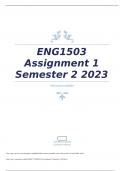ENG1503
Assignment 1
Semester 2 2023
[Document subtitle]
[COMPANY NAME]
[Company address]
This study source was downloaded by 100000852290574 from CourseHero.com on 09-02-2023 13:48:05 GMT -05:00
https://www.coursehero.com/file/208817732/ENG1503-Assignment-1-Semester-2-2023docx/
, ENG1503 Assignment 1 Semester 2 2023
Read the text below and answer the following questions in short paragraphs of
not more than 150 words each Do not quote directly from the text unless you
are instructed to do so. Mental health impacts of the COVID-19 pandemic on
children and youth – a systematic review Pandemics and other large-scale
emergencies have the potential to negatively affect mental health during the
event and long after. In response to the COVID-19 pandemic, mitigation
measures have interrupted in-person learning, social and community
networks, recreational activities and access to health care, challenging access
to important routines, social structures, resources, and supports. While these
measures are necessary to prevent an escalating public health emergency,
prolonged social isolation and home confinement may lead to immediate and
long-term mental health and well-being challenges (Kaufman et al., 2020;
Wang et al., 2020). Short-term factors contributing to mental distress during
the COVID-19 pandemic include concerns about SARS-CoV-2 infection and
subsequent health impacts, social isolation, and worsening social determinants
of mental health such as socioeconomic ENG1503/001/2023 5 stressors
resulting in stress and increased mental illness (Aknin et al., 2021). Mental
health impacts of disasters, such as depression, anxiety, post-traumatic stress
disorder, substance use disorder, as well as domestic violence and child abuse,
have been identified in settings such as the aftermath of the SARS epidemic,
9–11, Hurricane Katrina, and other humanitarian emergencies (Furr, Comer,
Edmunds, & Kendall, 2010; Galea, Merchant, & Lurie, 2020; Purgato et al.,
2019; Sprang & Silman, 2013; B. Tang, Liu, Liu, Xue, & Zhang, 2014; Tang,
Deng, Glik, Dong, & Zhang, 2017; Tol et al., 2011). The cumulative effect of
multiple risk factors and inadequate protective factors can reduce mental
well-being and increase vulnerability to mental illness emergence (World
Health Organization, 2014). Individuals at risk may experience new onset of
mental illness, while those with pre-existing mental health conditions may
experience symptomatic worsening, especially if mental health service access
is impeded (Moreno et al., 2020). The unprecedented reach of COVID-19
pandemic impacts necessitates urgent population-level monitoring of mental
health to optimize efforts for prevention and mitigation of its effects. Pre-
existing vulnerabilities, such as socioeconomic disadvantage, neurodiverse
needs, or disability may increase risk of poor mental health outcomes during
This study source was downloaded by 100000852290574 from CourseHero.com on 09-02-2023 13:48:05 GMT -05:00
https://www.coursehero.com/file/208817732/ENG1503-Assignment-1-Semester-2-2023docx/




